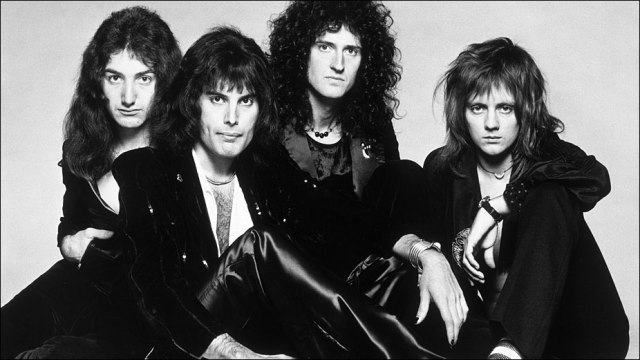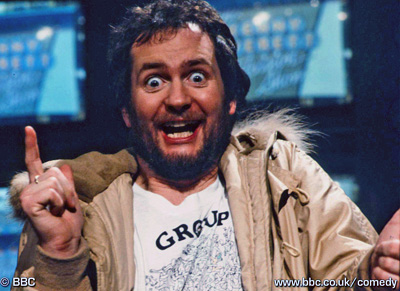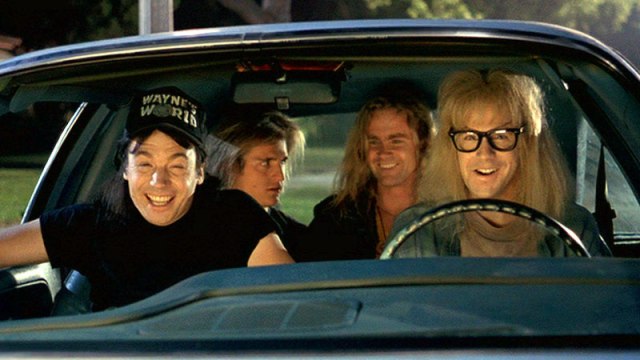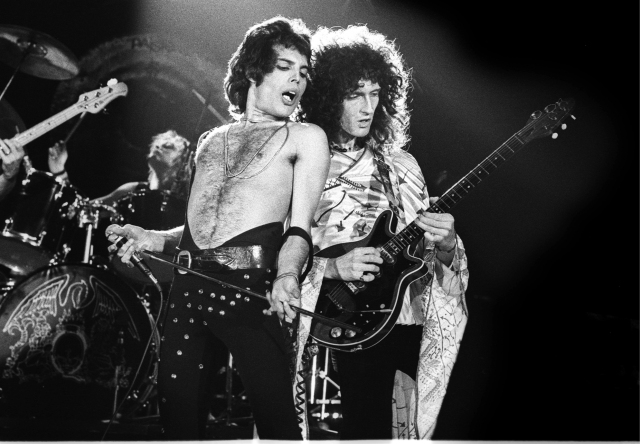First of all, I haven’t forgotten about the rest of the Don’t Stop Them Now tour, or that Adam has been out and about doing solo work, but real life is seriously getting in the way at the moment. I won’t bore you with the details, but I will try to catch up with everything soon, and also hopefully include some material from other contributors who were lucky enough to go to South America.
There has been a very important music anniversary this weekend, as on 31st October 1975 this happened:
(video from Queen Official’s YouTube uploads)
This extraordinary song, which by right shouldn’t have been a single release at all, has managed to be the third best seller ever (behind Band Aid’s Do They Know It’s Christmas and the “Diana” version of Candle In The Wind). It’s even been number one twice in an identical version, the only song ever to manage this feat.
How the hell did Bo Rhap happen? Do we have any idea why it’s captured the imagination the way it has for four decades? What makes it unique? And is it really a rhapsody?
There have been masses of column inches written about this song over the last 40 years; there is a very detailed entry about it on Wikipedia and there have been all sorts of analyses done of it, including how it’s put together musically and various theories about what the words mean. So I’m not going to go over stuff that already exists, but instead give you my take on why I think it’s become an iconic piece of music.
At the time Queen recorded Bo Rhap, they were very much at a crossroads. Locked in a legal battle about finances, the band had hit records, but were broke – in rock star terms, at least. They needed something massive, but record company executives were very doubtful about a six-minute song getting the radio play that would make it a hit.
Enter an anarchic DJ called Kenny Everett.
Everett had a completely eccentric broadcasting style which gave him considerable notoriety. He pushed the boundaries a little too far for the BBC’s tastes at the time, and got himself sacked from Radio 1 in 1970. He moved over to Capital Radio and whilst there worked hard to champion the bands that he believed in. One of them was Queen and he was the first DJ to air Bo Rhap on the radio – in fact, he managed to get it played no less than fourteen times on that first weekend. He utterly believed it was a record that was going to blow everyone away.
(video from QueenMuseum.com’s YouTube uploads)
Once Bo Rhap had made it on to the airwaves, the public imagination was captured and as they say, the rest is history. It spent an unprecedented nine weeks at number 1 in the UK in 1975-76. It also spawned what is acknowledged to be the first “real” pop video. Queen were never keen on Top of The Pops; in any case they were touring at the time the song was number 1 and it would have looked pretty ridiculous to attempt to mime a song of that complexity.
Its second spell at number 1 came after Freddie’s death in 1991 and it became the first song to be number 1 twice in the same version, and also the first song to be number 1 twice at Christmas. It has won many music industry awards and has also been voted high in many polls of favourite songs and influential songs. In 1992, it featured in the film Wayne’s World and even won an MTV Video Music Award for this appearance.
Bo Rhap has also managed to transfer into many different mediums. It has been covered by artists as diverse as Elaine Paige, Montserrat Caballe and Kanye West (although the less said about that, the better). It’s been played on fairground organs, by symphony orchestras, in carillons (that is, on bells), and sung by cats, choirs and even the Muppets. This is a particularly fab version by a girls’ choir – wait and see what they do with the headbanging section!
(video from Katie Lee’s YouTube uploads)
I think that the song’s sheer versatility is the reason why it’s captured the imagination and also why it’s so unique. I must have heard it thousands of times over the 40 years it’s been around, but it simply reaches the places that so many other songs don’t because of the way it’s been put together. It’s almost impossible to classify; is it a ballad? Opera? Hard rock? It’s actually all of these things and more.
One of the most striking things about Bo Rhap is that is doesn’t have a chorus; it is composed of a number of very different sections, with very few of the thematic ideas repeated. Most pop songs are written to a format that is:
Introduction – verse – chorus – verse – chorus – bridge (or middle 8) – chorus – conclusion (musos like to call this a coda)
There are some variants to this, but most of the time there are a number of verses, a chorus and a bridge section. This form of songwriting isn’t new at all and there are similar “verse and chorus” song structures that go back hundreds of years.
But in the late 60s, prog rock moved away from this style and into structures that were much more associated with classical music. There were even a number of experiments at putting prog rock and classical music together, such as Deep Purple’s Concerto for Group and Orchestra, which was recorded in 1969. Many other prog rock bands used these experimental styles and some early Queen songs, such as My Fairy King and The March Of The Black Queen were clearly influenced by them.
In addition to the prog rock influences, there is the “opera” factor. Multi-layered vocals in pop songs had been used before; they were beloved of the Beach Boys and just a few months earlier in May 1975, 10cc released I’m Not In Love which used massed vocal effects. But as ever, Queen used the “too much is never enough” principle and recorded 180 voices (Freddie, Brian and Roger x 60; John Deacon didn’t sing) to build the central section of the song. It isn’t just lots of voices; it has hints of Mozart and Verdi and at the time, sounded simply outrageous.
There is a recording of the vocals and guitar solos isolated; this is well worth listening to as you can hear how the vocals have been constructed. The thing that jumps out at me immediately is how accurate everything is, both from the point of view of timing and also the tuning; these are three guys with untrained voices (except for Roger’s choirboy training) and they are precise as some professional choralists. It’s also very interesting to hear the rasp of the guitar strings in this stripped-down version, as that’s often covered up by the sound engineering processes.
(Video from NetMusic.com Presents: ‘Vocals Only’ Videos YouTube uploads)
And what about the lyrics? There have been pages of discussion about these; are they Freddie working out his issues with relationships, even expressing his homosexuality? The opera section has been taken apart word by word, and although there are many theories, there is no definitive version and Freddie himself wrote it off as “nonsense that rhymed”. If the band know the real mearning of it, they’re not saying. From the point of view of someone who has spent the last 30+ years around opera, I think it’s a pretty good pastiche of what you would expect opera to sound like. Is the “Galileo” reference about Brian’s background in astronomy? Scaramouche is a character in Commedia dell’Arte, which Freddie was fond of, and Figaro definitely appears in a couple of popular operas. Make your own choices on all this…
My view about Bo Rhap is that a piece of music with so many different thematic ideas shouldn’t work; in most hands a composition like this would be disjointed – overloaded even. But I think it shows the touch of genius that the song moves seamlessly from section to section and from style to style. Between the four of them, and steered by Freddie’s overview of the song that he had in his head, they managed to stitch this together in just the right way.
And – is it a rhapsody? According to the wonderful Wikipedia, in music a rhapsody is defined as “a one-movement work that is episodic yet integrated, free-flowing in structure, featuring a range of highly contrasted moods, colour and tonality”. So… yes, I reckon it is. It ticks all of those boxes and bought together rock and opera in a way that nobody else has done before or since.
Many happy returns, Bo Rhap – I tweeted a couple of days ago that people will still be listening to it in 2075. I doubt I’ll be around then, but if someone could have a seance and let me know, I’d be very grateful.






Great blog. And I enjoyed the two videos posted. Could there be another BoRhap? I say YES. With Adam Lambert’s voice and the creativity and musicianship of today’s members of Queen it is possible.
Years ago a friend of mine wrote a blog about Adam as he was struggling to get his music played on American Top 40 radio, stating that what he needed was a “BoRhap 2.0.” He needs a song that showcases his classically trained and rock god voice, a song that many try to perform but fall way short. I sincerely hope that Queen continues to give Adam a place to SHOW OFF. It saddens me that with every album Adam puts out he chisels the edges off of his square peg to fit into the round hole of American pop music.
LikeLike
Love this, you always give great insight into music. There was a lot of interesting music back in the day 🙂 This song blows all away tho, it is true genius in that at times you are not sure if he was daft to put all this together LOL a fine line and all that. Your comment it shouldnt work is quite right in a way but there are certain artists that can make almost anything work by sheer power of their will / personality and talent, Freddie was one of those. Its dazzeling and messy at the same time but oh so Freddie. Amazing it got played at all and thank god for that, it will be hailed as an amazing song for all time.
LikeLike
Thank you, I really enjoyed your article, especially the video of the choir girls.
LikeLike